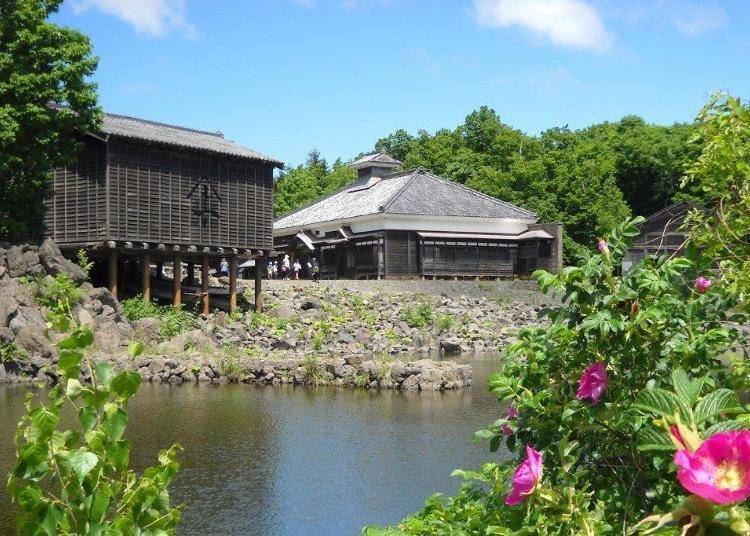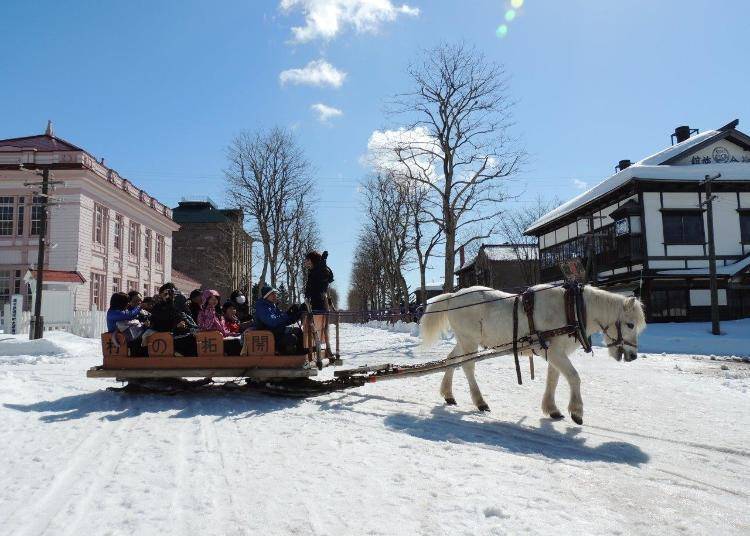
Historical Village of Hokkaido: Visit the 'Pioneer Village' That Inspired A Popular Manga Series
- Written by: Minna no Kotoba Sha
At the Historical Village of Hokkaido, you can experience Japan's pioneering days at this open-air architectural museum in Sapporo City.
Many such buildings and locations have recently been the focus of attention due to the growing number of visitors going on "pilgrimages" to historical sites featured in the popular manga series, Golden Kamuy.
In this guide, we'll share some highlights of this unique Hokkaido attraction.
- Table of Contents
-
- Experience Hokkaido history as it was during its reclamation period!
- Town area: The very same buildings featured in "Golden Kamuy"!
- Farm Village: See Hokkaido’s prized agricultural traditions and the roots of the old migrants
- Fishing Village Area: Impressions of the peak herring season that livened up the shores of Hokkaido
- Mountain Village Area: Reproducing the lumber and charcoal huts made solely from forest materials
- A range of activities let you experience Japan's pioneer period
- Don't miss the guided tour of the Historical Village of Hokkaido in English!
- Famished after checking out Hokkaido history? Enter the village cafeteria!
- How to get to the Historical Village of Hokkaido
Experience Hokkaido history as it was during its reclamation period!

The Historical Village of Hokkaido is the reconstruction of a town developed from when migrants from Honshu settled down here in Hokkaido during the early Meiji era until the start of the Showa period (i.e., 1868 to 1920).
The area inside is divided into several zones, starting from the town area to the agriculture area, the fishing village area, and the mountain village area. Each zone has unique scenery that sets it apart from the others.
Town area: The very same buildings featured in "Golden Kamuy"!
The first stop at this interesting Hokkaido point of interest is the Town area, where various official buildings and shophouses are lined up.
Many buildings featured in the manga Golden Kamuy, a Hokkaido history series set during the period when the Japanese central government intended to absorb Hokkaido (then known as Ezochi), are located here.






Farm Village: See Hokkaido’s prized agricultural traditions and the roots of the old migrants
The Farm Village is lined with buildings unique to Hokkaido, such as buildings belonging to colonizers and pioneers. Hokkaido is home to many people from different regions of Japan. As such, many of the buildings and houses here also reflect some of their homeland's unique architectural properties.



Fishing Village Area: Impressions of the peak herring season that livened up the shores of Hokkaido

During the era of Hokkaido's pioneering, herring fishing was Hokkaido's primary industry. This area is a faithful reproduction of the fishing industry along the coast of the Sea of Japan that prospered with the contributions of the herring fishing sector, complete with fishing equipment and boats to replicate the bustle of the period.

Mountain Village Area: Reproducing the lumber and charcoal huts made solely from forest materials

Next, the Mountain Village area faithfully recreates the lumber and fuelwood facilities, which utilized the abundant resources from the forest at the time. Even the railway that was used for transportation is also on full display.
A range of activities let you experience Japan's pioneer period
There's more than just sightseeing at the Historical Village of Hokkaido. You can learn a bit of Hokkaido history and experience the reclamation period's means of transportation, from horse-pulled rail carriage rides from spring to autumn and horse sled riding in the winter.
Guided tours by volunteers, as well as trying out traditional tools, are just some of the activities you can try out here to get a deeper understanding of the lives of the migrants living in that revolutionary period.

A horse-drawn carriage train runs on the main street from urban areas to fishing villages. The buildings and scenery give a very different feel when seen with the gentle rocking of the carriage compared to when walking.

Horse sleigh rides operate during the Sapporo Snow Festival from mid-December to March, with a one-of-a-kind view of the snowy landscape of the village from the perspective atop a horse sled! It's a fun thing to do in Hokkaido during your stay.
The fare for the horse-drawn carriages and sleds is 250 yen for adults (15 years and over) and 100 yen for children (3-14 years).
Don't miss the guided tour of the Historical Village of Hokkaido in English!

What better way to learn about the history of pioneering in Hokkaido than through a volunteer guide? Commentary and guided tours in English are available for booking at least one week before the tour. Above is a picture of two guides dressed in the old constable attire.

A live demonstration of a foot press by a volunteer guide. Other demonstrations include selling dagashi (cheap sweets native to Japan), toolmaking and fishing gear-making.
Famished after checking out Hokkaido history? Enter the village cafeteria!
If you're starving after all that informative sightseeing, you can fill your bellies at the village food hall. Traditional teishoku set meals aside; they also serve Jingisukan (Mongolian-style BBQ), miso ramen, and other Hokkaido specialty dishes. They even serve the Hokkaido-only drink, "Co-up Guarana."

The herring soba noodles (980 yen, 1030 yen for upsizing) is one of Hokkaido's signature dishes and is also popularized as a dish the characters in the abovementioned popular manga ate. A simple soba dish that synergizes with the sweetened boiled herring.

The template dish among template dishes, the imomochi (160 yen for one, 310 yen for two). Kneaded with potato and starch, this mochi is salty-sweet due to the sugar and soy sauce that's topped on. You can order some for takeout, and they even sell pre-frozen packs (packs of 5 at 650 yen).

The Tondenhei set meal (1,030yen) is another popular item. Red kombu rice made with red salmon and red kelp from Hokkaido, together with steamed potato dumplings, tonjiru pork soup, miso oden, a set with plenty of volume in a snug bowl. Note that the term Tondenhei refers to the soldiers engaged in security and reclamation in Hokkaido during the Meiji era.
The Historical Village of Hokkaido is where you can feel like you've traveled back in time just by walking around. For those wanting to discover more about Hokkaido, there's no better spot than here.
How to get to the Historical Village of Hokkaido
●Via Public Transport:
If taking via JR, alight at Shin Sapporo Station, 10 minutes from Sapporo Station, and 28 minutes from Shin Chitose Airport Station via the express train. If taking the subway, alight at the Tozai subway line's Shin Sapporo Station, 20 minutes from the Tozai subway line's Odori Station.
Next, walk to Shin Sapporo bus terminal's north lane from either Shin Sapporo Station or Odori Station. Board bus 10 towards the "Historical Village of Hokkaido" and alight at the terminal. The trip takes 20 minutes, and the fee is 210 yen per person.
●Via Car
From the JR Sapporo Station area, enter the National Highway 12 towards Ebetsu City via the Kita 1-jo Road.
Or, from New Chitose Airport, enter the National Highway 12 towards Ebetsu City via the Kita 1-jo Road via the Central Hokkaido expressway "Sapporo South Interchange."
Text by: Mina no Kotobasha
Minna no Kotoba Sha is a production company founded by an editor with extensive experience in editing local magazines in Sapporo. For over 20 years, our team has conducted research and written articles across Hokkaido, with Sapporo as our primary hub. Our diverse portfolio includes the production of various books such as travel guides, informational magazines, and collections showcasing the picturesque landscapes of Hokkaido. Comprised entirely of women, the team at Minna no Kotoba Sha boasts diverse interests, including a passion for travel, culinary delights, and alcoholic beverages. The scope of our communication efforts spans a wide range, covering everything from introducing notable restaurants to providing coverage of local events and sharing stories of leisure experiences.
*Prices and options mentioned are subject to change.
*Unless stated otherwise, all prices include tax.
Popular Tours & Activitiess
Recommended places for you
-

Niseko Village Ski Resort
Skiing & Snowboarding
Niseko / Rusutsu
-
Appealing

Otaru Canal
Rivers, Lakes & Canyons
Otaru
-
Appealing

Rukku and Uohei
Izakaya
Sapporo / Chitose
-

LakeAkan
Rivers, Lakes & Canyons
Abashiri
-

Sapporo Clock Tower
Landmarks
Sapporo / Chitose
-
Appealing

Odori Park
Parks
Sapporo / Chitose
-
Ad

Smart Ways to Avoid Crowds and Enjoy a Safe, Comfortable Trip to Otaru.
-
Ad

Smart Ways to Avoid Crowds and Enjoy a Safe, Comfortable Trip to Noboribetsu Onsen
-

7 Iconic Hokkaido locations that will make your Instagram shine
by: Himanshi Shah
-

Great Local Eats: 5 Expert-Recommended Local Chain Restaurants in Hakodate
by: Nobuka Kawashima
-
Ad

Sapporo SATUDORA Shopping Guide: Get Souvenirs, Medicine & More at This Iconic Drugstore (Special Deal Inside!)
-

Beyond Hakodate and Matsumae: Enjoy the Hidden Gems of Hokkaido’s Donan Area
-

Otaru Travel Guide: Inside Hokkaido's Leading Destination (Sightseeing, Food, and Shopping Tips)
-

These 18 Things to Do in Hakodate Will Make You Fall in Love With the Northern Wonderland
by: Guest Contributor
-

JR Edition: Visit all of Tokyo in one Day with the Tokyo Metropolitan District Pass!
-

6 Surprisingly Cheap Things in Japan
-

Hokkaido Lavender Fields: 6 Best Places in Furano to See Japan's Dreamiest Purple Meadows
by: Nobuka Kawashima
-

Hakodate 2-Day Itinerary for Exploring Japan's Foodie North!
- #best sushi hokkaido
- #things to do hokkaido
- #best ramen sapporo
- #what to bring to japan
- #new years in tokyo
- #what to buy in ameyoko
- #japanese nail trends
- #what to do in odaiba
- #onsen tattoo friendly tokyo
- #daiso
- #best sweets otaru
- #japanese fashion culture
- #best nature furano
- #japanese convenience store snacks
- #best japanese soft drinks


















